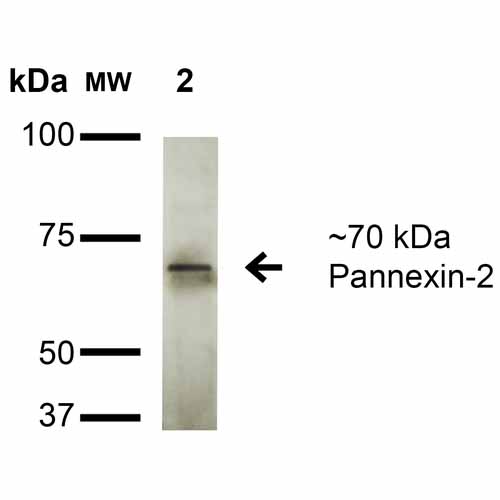Pannexin-2 Antibody
Pannexin 2 Antibody, Clone S121A-31
- SPECIFICATION
- CITATIONS
- PROTOCOLS
- BACKGROUND

Application
| WB, IHC, ICC |
|---|---|
| Primary Accession | P60571 |
| Other Accession | NP_955441.2 |
| Host | Mouse |
| Isotype | IgG1 |
| Reactivity | Human, Rat |
| Clonality | Monoclonal |
| Description | Mouse Anti-Rat Pannexin-2 Monoclonal IgG1 |
| Target/Specificity | Detects ~70kDa. Does not cross-react with Pannexin-1 or Pannexin-3. |
| Other Names | Pannexin 2 Antibody, PANX2 Antibody, PX2 Antibody, hPANX2 Antibody, MGC119432 Antibody |
| Clone Names | S121A-31 |
| Immunogen | Fusion protein amino acids 11-664 (all but first 10 amino acids, encompassing extracellular and cytoplasmic domains) of rat Pannexin-2 |
| Purification | Protein G Purified |
| Storage | -20ºC |
| Storage Buffer | PBS pH7.4, 50% glycerol, 0.09% sodium azide |
| Shipping Temperature | Blue Ice or 4ºC |
| Certificate of Analysis | 1 µg/ml of SMC-420 was sufficient for detection of Pannexin-2 in 20 µg of rat brain lysate by colorimetric immunoblot analysis using Goat anti-mouse IgG:HRP as the secondary antibody. |
| Cellular Localization | Cell Membrane | Cell Junction | Gap Junction |

Thousands of laboratories across the world have published research that depended on the performance of antibodies from Abcepta to advance their research. Check out links to articles that cite our products in major peer-reviewed journals, organized by research category.
info@abcepta.com, and receive a free "I Love Antibodies" mug.
Provided below are standard protocols that you may find useful for product applications.
Background
Gap junctions are formed by a hexameric group of proteins called connexions for the transport of low molecular weight proteins from cell to cell. Connexins, which are present in all metazoan organisms, serve diverse functions ranging from control of cell growth and differentiation to electric conduction in excitable tissues. Several mammalian cells with malignant phenotypes exhibit decreased connexin expression and gap junction communication. The pannexin gene family encodes a second class of putative gap junction proteins. Pannexins are highly conserved in invertebrates and mammals, indicating the importance of their gap junctional coupling function. Mammalian Pannexin-1 and Pannexin-3 are closely related, while Pannexin-2 is more distantly related. Pannexin-2 is a transmembrane protein expressed in the central nervous system that is unable to assemble in homomeric channels but forms heteromeric channels with Pannexin-1.
References
1. Bruzzone R., et al. (2003) Proc. Natl. Acad. Sci. USA 100: 13644-13649.
2. Bao L., et al. (2004) FEBS Lett. 572: 65-68.
3. Baranova A., et al. (2004) Genomics 83: 706-716.
4. Vogt A., et al. (2005) Brain Res. Mol. Brain Res. 141: 113-120.
5. Bruzzone R., et al. (2005) J. Neurochem. 92: 1033-1043.
6. Panchin Y.V. (2005) J. Exp. Biol. 208 (Pt. 8): 1415-1419.
7. Söhl G., et al. (2005) Nature reviews. Neuroscience 6: 191-200.
8. Ray A., et al. (2005) Eur. J. Neurosci. 21: 3277-3290.
9. Barbe MT., Monyer H. and Bruzzone R. (2006) Physiology 21: 103-114.
If you have used an Abcepta product and would like to share how it has performed, please click on the "Submit Review" button and provide the requested information. Our staff will examine and post your review and contact you if needed.
If you have any additional inquiries please email technical services at tech@abcepta.com.













 Foundational characteristics of cancer include proliferation, angiogenesis, migration, evasion of apoptosis, and cellular immortality. Find key markers for these cellular processes and antibodies to detect them.
Foundational characteristics of cancer include proliferation, angiogenesis, migration, evasion of apoptosis, and cellular immortality. Find key markers for these cellular processes and antibodies to detect them. The SUMOplot™ Analysis Program predicts and scores sumoylation sites in your protein. SUMOylation is a post-translational modification involved in various cellular processes, such as nuclear-cytosolic transport, transcriptional regulation, apoptosis, protein stability, response to stress, and progression through the cell cycle.
The SUMOplot™ Analysis Program predicts and scores sumoylation sites in your protein. SUMOylation is a post-translational modification involved in various cellular processes, such as nuclear-cytosolic transport, transcriptional regulation, apoptosis, protein stability, response to stress, and progression through the cell cycle. The Autophagy Receptor Motif Plotter predicts and scores autophagy receptor binding sites in your protein. Identifying proteins connected to this pathway is critical to understanding the role of autophagy in physiological as well as pathological processes such as development, differentiation, neurodegenerative diseases, stress, infection, and cancer.
The Autophagy Receptor Motif Plotter predicts and scores autophagy receptor binding sites in your protein. Identifying proteins connected to this pathway is critical to understanding the role of autophagy in physiological as well as pathological processes such as development, differentiation, neurodegenerative diseases, stress, infection, and cancer.



